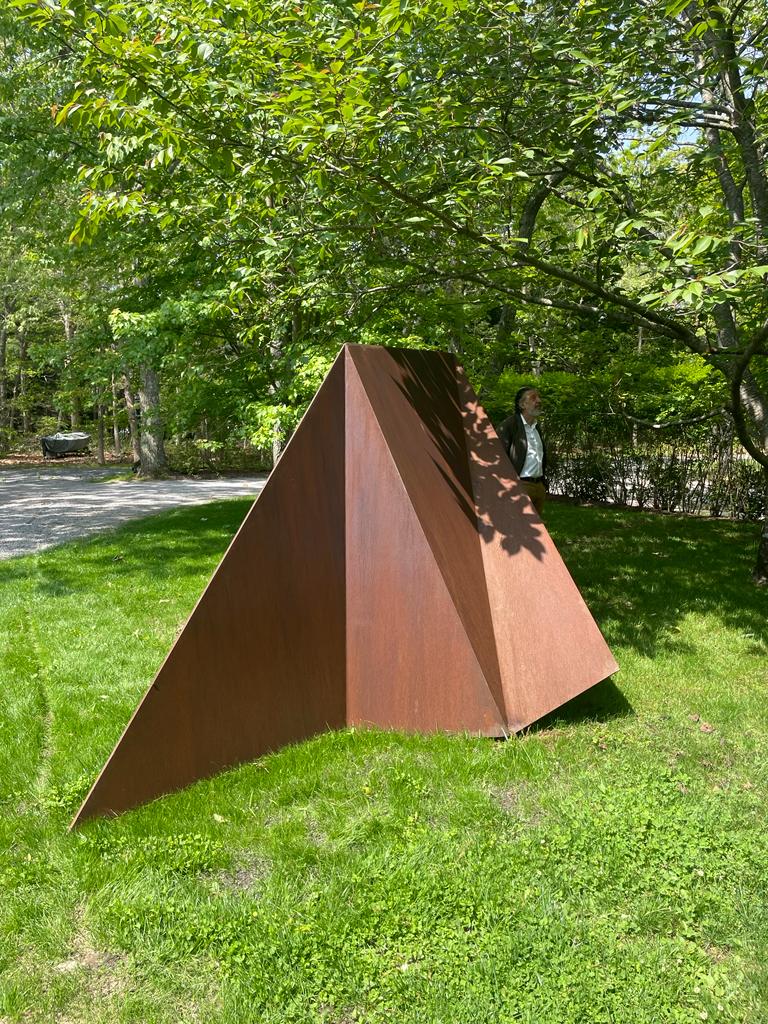Matias Di Carlo Unveils New Work in The Hamptons


Eastern Long Island, the Hamptons, has long been a popular refuge for artists with greats like Lee Krasner and Jackson Pollock, establishing studios there in the 1950s, and before them Thomas and Mary Nimmo, in the 1880s—both studios are preserved and can be visited. Not only has the area with its galleries and museums become an art destination for tourists, but it is also the home of many art collectors. With the help of his Marbella-based gallery Wadström Tönnheim, Argentinian artist Matias Di Carlo recently installed one of his large-scale Corten steel sculpture works in the garden of a private residence in the area. The artist has a studio in Andalusia since 2002 where he works with sculpture on larger and smaller scales. The newly installed piece titled “Mar,” meaning water, in the Hamptons is part of the five-piece series “Bitácora de los elementos” and embodies the process of driving a flat object considered two-dimensional to a multi-dimensional work that has an intervention in space.

Di Carlo exhibited smaller works in Wadström Tönnheim’s booth at VOLTA. The gallery’s roster includes several artists who come from lineages of makers. Also exhibiting in the booth, Claudia Doring Baez’s mother was an artist, Di Carlo stems from a family of blacksmiths, and Johan Wahlström is a fifth-generation painter. Gallerist Matthias Tönnheim’s mother was a painter. It is perhaps this creative pedigree that gives them their near-obsessive engagement with their materials.

On the heels of art week and on the occasion of the acquisition and installation of the artists’ sculpture we caught up with Di Carlo about his work.
Anna Mikaela Ekstrand: What characteristics draw you to metal? What kind of ‘personality’ does the material have?
Matias Di Carlo: As I come from a family of blacksmiths metal and fire are the smells of my childhood. But, my love for Corten steel was born thanks to the work of the American sculptor Beverly Pepper who was the first artist to work with the material. Corten steel has a kind of poetry imprinted into it as it is affected by the elements, weather for instance. To me steel is a logical material to work with, however, I use various aluminum alloys from recovered and cast scrap as a starting point which necessities me to work with the material’s refinement process gaining a deeper engagement with its properties.
AME: Right. You told me about your process—melting down scrap metal, removing the impurities, pouring it into a mould—to make pieces. And, that when you are not content with a piece you remelt it and start over again. What is the relationship between alchemy and form in your process?
MDC: Alchemy is something that you create but cannot control; it occurs when the ego plays second or third fiddle to process and material. In this philosophy of making, form is born from intuition allowing the material to express its true nature.
AME: It makes sense to me that you would respect the materiality of steel in this way, as your smaller works have, well I do not want to call them imperfections, but rather irregularities on its surface. What are some mistakes you have made working with metal and what were the ramifications?
MDC: In my “Symmetry Ploy“ and “Junctions“ series I force the traditional casting method to create non-predictable results which showed me a new path.
AME: You are initially Argentinian, how did you end up in Spain and do you return to Argentina and if so, what do you do there?
MDC: Yes, I was born in Buenos Aires and then I moved to Spain to the Malaga region where I have my studio and all the means of production that allow me to create works ranging from the scale I showed at Wadström Tönnheim at VOLTA up to several tons—liek the one in the Hamptons. Working in different scales allowed me to find my own place in relation to my work. When you confront pieces that are literally like buildings in size the perspective of the viewer changes dramatically, and going back to a gallery format one must be able to play with the reduction of one’s own work.
AME: It is interesting how you consider the reduction in terms of scale. You create work for both exteriors and interiors, public spaces and private—what are your considerations while you move between these various placements?
MDC: I do not usually make a special division in my work depending on who will own the work, but I always consider how the work will dialogue with the surroundings. My experience in San Francisco, Menlo Park, for instance, was very positive and it is always exciting to work for public spaces.
AME: Right, you were the lead artist for the Menlo Park commission. Exciting. And, last week showed at VOLTA also with Wadström Tönnheim. How does New York inspire you?
MDC: New York is the most vibrant city I have visited to date! I received great feedback at VOLTA and several galleries expressed an interest in promoting my work so I am seriously considering creating a bridge between Spain and America.
You Might Also Like
Claudia Doring Baez and Ellen Frances 1950s Nostalgia
Skip the Hamptons Jitney and Take the Ferry to Rockaway
What's Your Reaction?
Anna Mikaela Ekstrand is editor-in-chief and founder of Cultbytes. She mediates art through writing, curating, and lecturing. Her latest books are Assuming Asymmetries: Conversations on Curating Public Art Projects of the 1980s and 1990s and Curating Beyond the Mainstream. Send your inquiries, tips, and pitches to info@cultbytes.com.

